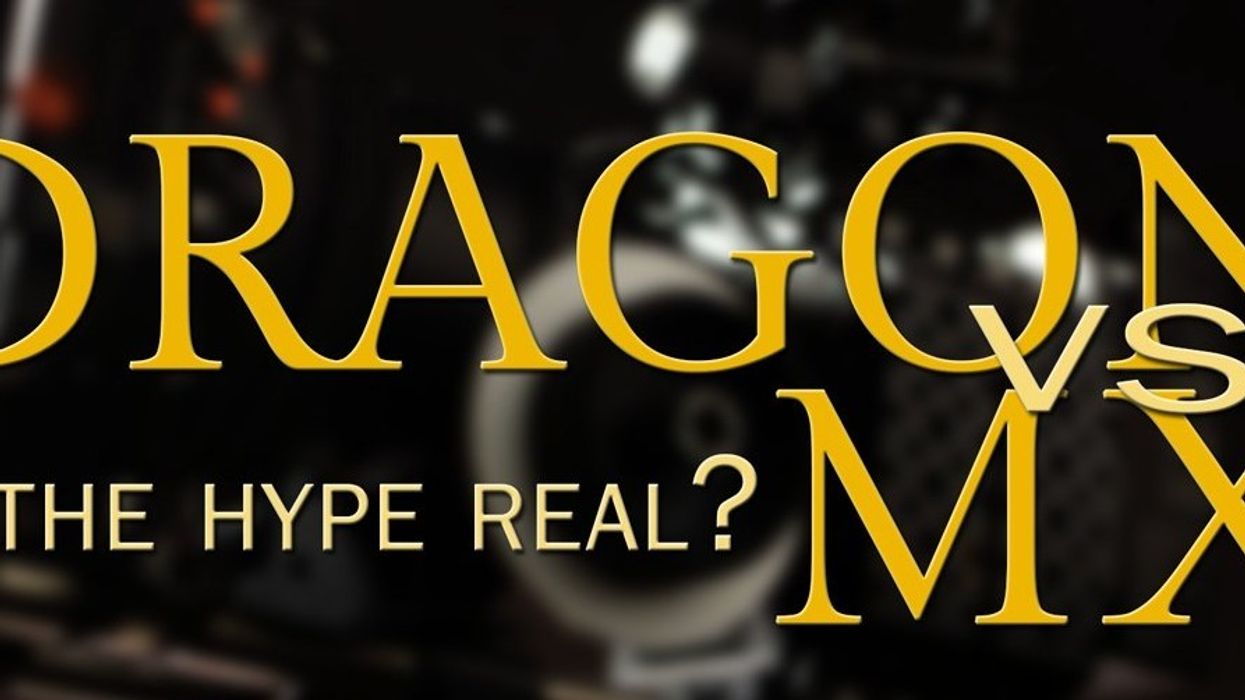Dueling with DRAGON: RED's 6K Sensor Takes on Older MX in This EPIC Camera Shootout

With DRAGON now available for purchase or upgrade in RED's EPIC and SCARLET cameras, it's about time to see how well the new sensor outperforms its predecessor, the Mysterium-X. Cinematographer Ryan Walters has recently done just that at Indie Cinema Academy. His battery of tests compare everything from overall latitude, highlight handling, recoverable underexposure, low light performance, IR pollution, and more between two EPICs -- one old and one new. Needless to say, if you're thinking of upgrading or simply wondering how all the DRAGON hype stacks up to reality, you definitely want to check out his results.
Headroom & Footroom: Exposure Latitude/Dynamic Range
Ryan's first series of comparisons evaluate what may be the most important -- and one of the most hyped -- of DRAGON's improved capabilities: exposure latitude. He also dips the DRAGON's toes into the icy ponds of underexposure, where things get more subjective than in the case of clipping highlights.
While DRAGON's greater highlight shoulder is undeniable, in this case the MX seems to have a leg up on the newcomer in recoverable shadow details. Look no further than in the underexposure examples Ryan provides in his post, wherein it appears the MX preserves darker areas significantly better than DRAGON does. Even in the relatively tiny crops below, the difference is immediately apparent with a glance side by side (courtesy Ryan Walters & Indie Cinema Academy):
So why is DRAGON going so dark so quickly? Possibly as a by-product of the new OLPF for DRAGON, which does improve several things over the old OLPF. RED's Jarred Land had this to say over at REDUser (my emphasis):
There still people that prefer the old OLPF because even though skintones and highlight protection isn't as good as the new OLPF, they want a noise free image at higher ISOs that the old OLPF gives you by letting in more light. We of course will put whichever OLPF you want in your camera now -- but the new OLPF module will make things a lot easier to change.
RED is currently in private REDCINE-X testing phases for a feature called DRAGON Enhanced Blacks (or DEB), which DP Phil Holland says, "is tackling the 'red specks' that effect midtones, darks, and shadows." DEB doesn't directly address new-OLPF DRAGON's dynamic range -- or doesn't seem to, from the sound of things -- but at least some remedy is on the horizon for noise in darker areas of the image. It's also possible that improvements in image processing for new-OLPF DRAGON material could further aid shadow detail sometime in the future.
Filtration: Diffusion, ND, & IR
Next up, Ryan test drives the DRAGON's ability to cope with lots of ND filtration, which would normally start to introduce infrared pollution depending on the camera. While the ND does exactly that in the MX, this is an arena in which DRAGON soars high above:
DRAGON's robust insulation from IR means you have to worry a bit less about choosing the right neutral density to knock down exposure, allowing greater flexibility than the more vulnerable MX.
Quality & Accuracy: Fill, Compression, & Color
In his final video, Ryan tests remaining factors that influence the final image's beauty: skintone and color reproduction, shifts due to white balance, effective fill ratios, and compression artifacts.
With DRAGON, it seems less tweaking is necessary for natural skin and color balance out of the gate than with MX. Plus, with more spatial resolution than any prior RED sensor, EPIC DRAGON can oversample for its targeted destination even more so than the MX. This should make for less perceptible compression artifacts when downscaling to a given delivery format. Once again, however, DRAGON's shadow-area noise hurts its performance -- in this case at fill ratios which the MX handles just fine.
Incubating Some DRAGON Eggs
The issue of how DRAGON is 'better' than MX is a complicated one -- different configurations can affect the final image, and preferences will vary by shooter. Some may be disappointed with how quickly DRAGON drops into darkness, especially considering some of RED's optimistic earlier claims about its sensitivity. For those users, RED's modular OLPF program may come in handy. After all, Jarred Land has also said that "you can choose whichever [OLPF] you want or all of them and change at will."
Others may count new-OLPF DRAGON's greater headroom as a fair trade, taking shallower shadows as a sacrifice for stronger highlight handling. As Ryan indicates above, if you're mainly looking for a camera that sees in the dark, you may be looking in the wrong place. Whatever the case may be for you, hopefully now things are a bit more clear. There can certainly be some ambiguity separating a camera/sensor's specs from its actual imagery -- Ryan's tests help cut a greater contrast out of that gray area in between.
Be sure to check out all three of Ryan's original posts at Indie Cinema Academy in the links below. There you'll find pixel-peepable downloads, further discussion in the comments, and a place to thank Ryan for all his hard work!















